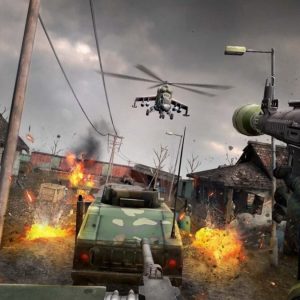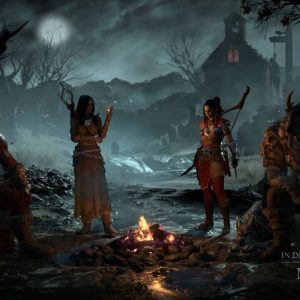Elden Ring Nightreign is a weird one. It takes the foundation of one of the best open-world RPGs of a generation and turns it into not just a roguelite where death is even more of a big deal, but a three-person, co-op-focused roguelite. And in many ways, that strange experimental concoction is a success. Under the right conditions, Nightreign’s 45-ish minute runs are positively thrilling. They are packed with surprising encounters, challenging decisions, satisfying opportunities for teamwork, and some of the best boss battles FromSoftware has ever come up with – and that’s a very high bar. The big problem, however, is that those right conditions are far more difficult to create than they should be. You really need to have a consistent squad of similarly skilled players that are able to devote hours at a time in order to see what makes Nightreign special – and when you don’t, the flaws of its design are magnified tenfold. There is excellence in this Elden Ring spin off, but it’s excellence that is just a little bit tarnished.
Let’s get the most important caveat out of the way first: If you are hoping to tackle Nightreign entirely solo, and are anything less than a hardcore Elden Ring player that actively seeks out ways to make that already difficult game even more challenging, Nightreign isn’t for you. Yes, there is technically a single-player option, but it is so poorly balanced that I would be shocked if it isn’t patched and adjusted within the first month of release. And this is coming from someone who lives and breathes these types of games.
To understand why, we first need to go over what Nightreign even is. On a very basic level, this is a roguelite that takes place on an island called Limveld, which is kind of like a melting pot of Elden Ring’s environments, enemies, bosses, and structures. The general flow of a run is split up into a three-day cycle: On days one and two, it’s all about farming gear, defeating bosses, and leveling up so that you’re as prepared as possible when you face off against one of the eight extremely difficult Nightlord bosses on day three. It’s a great formula, and while you might think that the mostly static map would get old after a while, there’s a good amount of procedural generation every run that mixes up the locations of every point of interest, requiring you to plan out a unique route on each new attempt. On top of that, there are also random events like boss raids, summoning portals, and other occurrences that inject a heavy level of chaos every once in a while.
Efficiency is key because you are on a very strict time limit, with a battle royale-esque circle that constricts at set points throughout the day, eventually shrinking to the size of a small battlefield and setting the stage for the boss battle that ends the night.
It is immediately obvious that Nightreign was designed with a three-player squad in mind. Enemy encampments that don’t require you to fight a single boss will instead have you spread out to takedown three tough enemies; basic encounters against five or more enemies that would be trivial with three players become costly time wasters when you’re on your own; and the new Nightlord bosses all seem explicitly designed with having allies in mind, and I’m not sure how I’d approach several of them by myself. Nightreign at least scales up your damage when you’re alone, but it doesn’t change any of these fundamental design decisions in any way that would make solo play more reasonable.
But the biggest issue is that co-op partners are able to revive each other when someone goes down, but you’ve only got one life to live when you’re on your own. That’s generally the case in roguelites, but usually there’s some sort of safety net that you can fall back on. For example: Hades has Death Defiances, and part of the progression of that game allows you to work toward unlocking more of them with every run; Returnal has artifacts you can find that give you extra lives, rewarding you for being more thorough in your exploration; Spelunky has shortcuts that allow you to skip the early stages and get practice on the enemies, traps, and bosses you only have limited experience with.
The list goes on and on, but Nightreign has virtually nothing to make up for the fact that solo players lose access to that crucial revival option. There is an item that will resurrect you once with half of your life, but it’s limited to the highest rarity tier, meaning you have to choose it over a legendary weapon if one does appear as a reward – similarly, you may find them in a shop, but they cost a substantial amount of runes that you could instead use to level up. Either way, it’s just not a solution that makes up for the crippling detriment of not having someone to revive you if you go down.
None of this is to say that solo play is outright impossible, and I have had a few successful runs on my own. Just that the balancing of solo play feels like a job half finished, and as a result, the frustration of playing alone wasn’t worth the triumph for me to have any desire to play more without a squad.
It Takes Three
Nightreign’s saving grace is that when you do have a squad of three people who all know what they’re doing, communicate well, and are generally pretty skilled at Elden Ring, it really is a lot of fun. The central idea of taking an entire game’s worth of progression and condensing it into a 40-minute run is a strong one. Going from cutting down rats with a basic weapon to culling Elden Ring’s most fearsome bosses with a badass armament that you may or may not have gotten to use in the main game is one of the coolest and most satisfying parts. It’s 80+ hours of character growth condensed into less than an hour and shot straight into your veins.
Dropping into a run the first couple of times is certainly overwhelming, mostly because of the amount of information on the minimap you have to process, but at least FromSoft keeps the inventory and stat management very simple. Level ups are automatic, letting you press a button at a Site of Grace to automatically level your class’s preferred stats. And as far as weapon stats go, all you have to worry about here is the damage number, the elemental affinity, the passive bonus you get simply for having the weapon in your inventory, and the weapon skill that comes along with it. This meant when I had a choice between three rewards, I was able to very quickly make a judgment on what I needed at that moment and continue on my way.
Eventually, I started to understand what rewards were offered at which camps, which ones were quick and could be cleared before the circle closed in, which ones I should only do if I had a lot of extra time, what level I should attempt certain roaming bosses, and which bosses I should absolutely avoid unless my team was really confident in our builds. Exploring these areas can be more frustrating than it needs to be thanks to a new wall climbing ability that feels straight up bad, especially when it takes three attempts to jump over what looks like it should be an easily scalable wall as you’re trying to escape the encroaching circle. But learning the ins and outs of the map helped my efficiency and led to a very satisfying feeling of skill progression that wasn’t tied to the actual progression system that offers persistent improvements between attempts.
That system is tied to relics that can be won after completing a run. Whether you win or lose, you still get relics, but the better you perform, the better the quality and quantity of relics you earn. These can be equipped before a run and impart stat bonuses, starting skills or elemental affinities for your initial weapon, buffs for performing certain actions, and in some cases, they can even improve the skills of a specific class. When you’re just starting out, these bonuses are hardly noticeable and too random to really make any sort of compelling build from. Eventually though, with enough runs under your belt, you’ll get some powerful relics that can really start to have an effect on your power level in a run.
That said, there really should be more of an element of choice with regards to the meta progression, or at least a way to control some of the randomness. There are a small selection of relics that you can buy at the Jar Shop inside your base before runs, and there are set relic rewards for beating Nightlord bosses and completing class-specific objectives called remembrances – but other than that, you’re completely at the mercy of the RNG gods when it comes to what relics you get. It can be really annoying when you’re looking to strengthen your preferred class and you keep getting relics that don’t do anything for you.
Select Your Nightfarer
One of the biggest departures compared to what we’re used to from Elden Ring is that the classes are now actual classes, with unique skills and gameplay styles as opposed to soft classes that just determine your starting stats and weapons. They’re called Nightfarers, and the eight options are varied and well defined, with even the more basic archetypes having some interesting twists to them. The Wylder, for instance, is the general jack of all trades, but also has access to a nifty grappling hook that can be used to pull weak enemies towards you, zip you toward larger enemies, or simply zoom you around the field at high speeds if you aim it at the ground.
In addition to the basic fighter, mage, and ranger archetypes, you also have a few completely unique choices that don’t fit into any pre-existing mold. One of the most interesting classes is the Executor, whose main skill has you pulling out a unique sword with a Sekiro-like parrying mechanic tied to it. Basically, by blocking attacks with proper timing, you completely negate damage, don’t lose any stamina, and reduce the enemy’s own stamina, potentially opening them up for a critical hit. It’s a very risky class, especially in a game where missing a parry can mean almost certain death, and it feels like the offensive power of the Sekiro sword is too weak to justify the risk of the parries, but I appreciate this inclusion nonetheless as both a nod to Sekiro, and as a completely different way to approach combat.
As mentioned, each of the classes has a remembrance tied to them, which is essentially a collection of journal entries that chronicle the story of how they wound up in Limveld and their purpose for being there. It’s a far cry from the rich lore that we’re used to in FromSoft games, but at least each remembrance has a handful of playable chapters that have you completing specific objectives in order to earn powerful relics, as well as a healthy amount of runes to help you level up during the actual run itself.
Almost all of Nightreign is made up of existing Elden Ring parts, but there are a few surprise bosses that are pulled from the Dark Souls series as well. But the eight Nightlords are brand new, and hoo boy, they’re almost all unlike any boss FromSoft has designed before. Many of them are clearly inspired by MMO boss battles, with a number of party-wiping attacks that must be stopped or interrupted before they get a chance to finish their preparation. Others are designed to split the party up into roles to either hold aggro or press the assault, and some are just designed to be all out wars against absurdly aggressive foes.
They’re almost all bangers, with only one of them being a dud due to the best strategy simply being hanging back and pelting them with arrows for what felt like an hour. Still, seven out of eight is pretty great, especially when those seven are among the very best FromSoftware has ever crafted, with excellent accompanying soundtracks to match. I don’t want to spoil them too much, but the fight against the Fissure in the Fog boss in particular is so good it gave me goosebumps all throughout.
But the creativity of those bosses once again shines a light on the eldritch elephant in the room: they only really work with a team, and by far the two biggest issues facing Nightreign right now are, one, the shocking lack of crossplay and two, the absence of a duos playlist (you will be forced to fill the third player with matchmaking). It is simply a lot to ask of a group of three people who all must have purchased the $40 game, play on the same platform, be of a similarly matched skill to be able to handle the extreme challenge of the day 3 bosses, have the time to devote at least 45 minutes per run, and also can all agree on fighting the same boss that they may or may not all need to beat for their own individual progression.
There is a decent pinging system that at least makes it possible for light communication with a group of randos, but there’s no built-in voice chat, which makes nuance like trying to communicate that your group should hit the basement of the castle instead of the front or side entrance virtually impossible. It’s just a night and day difference when you’re able to group up with a squad that communicates well and knows what they’re doing versus when you’ve got one that doesn’t listen to you or just constantly makes bad decisions, especially with no way to vote to cancel or quit out of a run without a penalty. That makes the prospect of random matchmaking on the live servers pretty unappealing.























